Nestled in the United States heartland, Oklahoma is known for its rich history, diverse culture, and beautiful landscapes. Oklahoma’s geographic diversity makes it a fascinating state to explore, from the rolling plains and grasslands to the rugged mountains. The Sooner State settles in as the 20th biggest of the United States.
Keep reading to discover Oklahoma’s actual size and much more!
Learn Some Facts About Oklahoma.
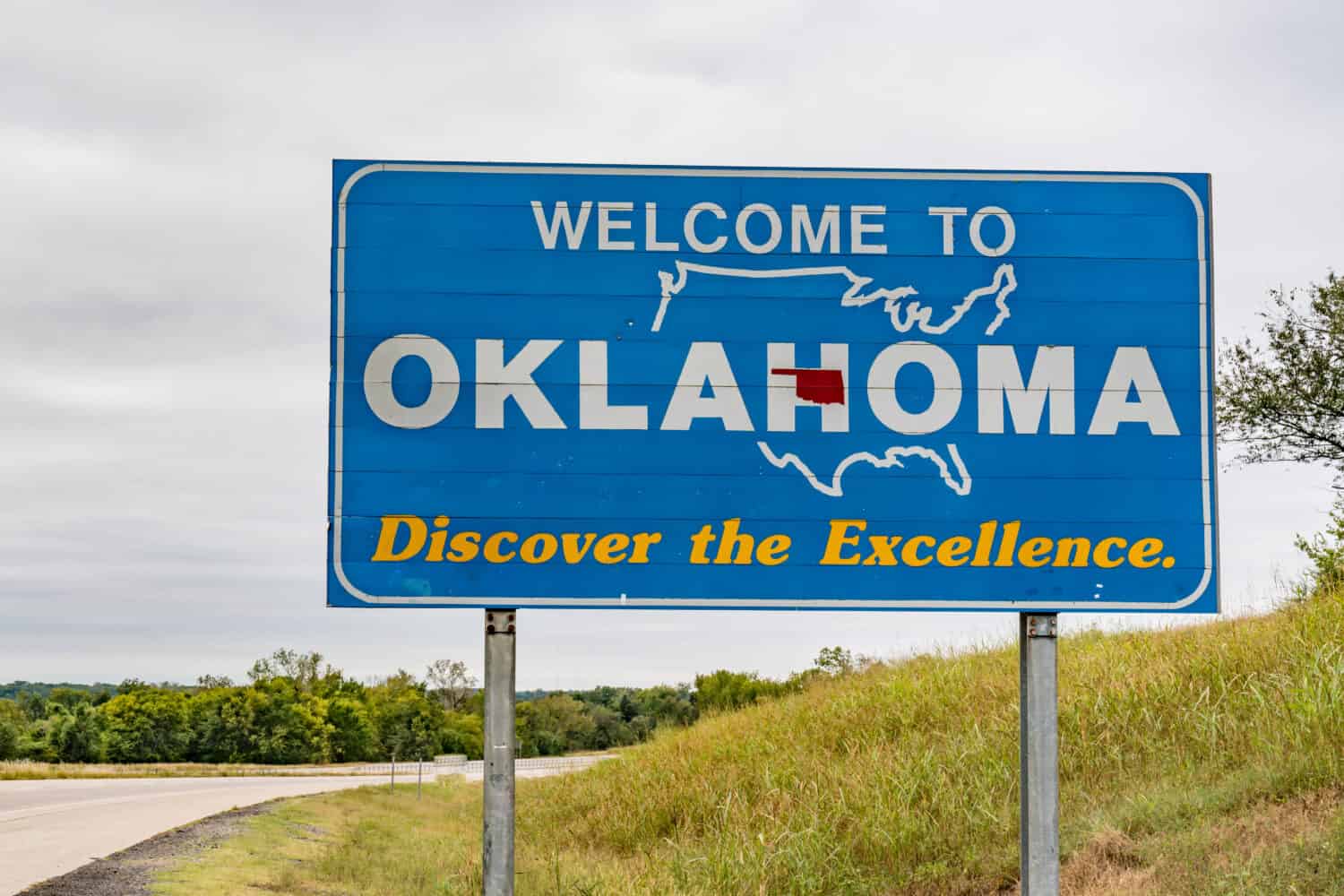
Oklahoma is located in the South Central Region.
©Paul Brady Photography/Shutterstock.com
- The state’s nickname, the “Sooner State,” came from the Land Rush in 1889. Settlers rushed into the Unassigned Lands to claim it before the settlement opening. Some of them arrived “sooner” than the designated time, hence the name “Sooners.”
- Oklahoma City is the capital of the state. Located in central Oklahoma, it is also the largest city in the state, with a population of just under 700,000.
- The state animal is the American bison. Successfully brought back to Oklahoma, this species is significant in the state’s history and culture.
- Oklahoma has an official state song since 1953 named “Oklahoma!” written by Oscar Hammerstein II and Richard Rodgers.
- The state is part of the region known as “Tornado Alley.” Each year from late spring through early summer, the state experiences a high frequency of tornadoes.
Oklahoma’s Dimensions
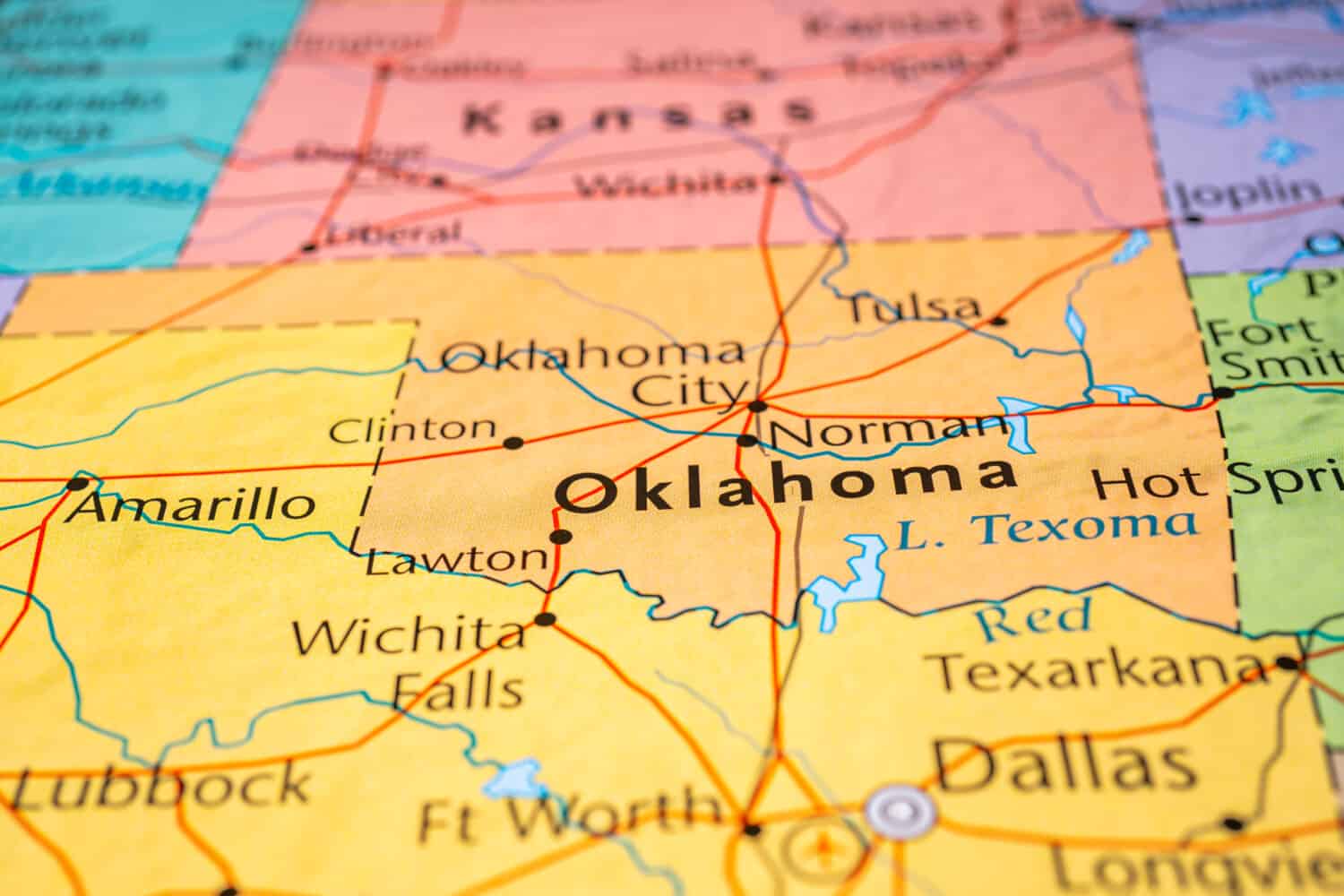
The state shares its borders with six others.
©Alexander Lukatskiy/Shutterstock.com
Square Miles
The 20th largest state in the country by area, Oklahoma, covers 69,898 square miles, which equals 181,035 square kilometers. The state extends from the southern Great Plains to the foothills of the Ozark Mountains, and its dimensions create a unique blend of geographical features that make it stand out among other states.
The Sooner State is divided into two extents. First is the north-south, which looks roughly rectangular at 230 miles (370 kilometers). It stretches from the Kansas border in the north to the Red River, and it forms its southern border with Texas.
And the east-west, 465 miles (748 kilometers), runs from the eastern border with Arkansas and Missouri to the western border shared with Colorado, New Mexico, and Texas.
Acres
Oklahoma is made up of 44,774,400 acres. The state has a similar size to Cambodia and can fit four times in Texas!
What Is Oklahoma’s Population?

A little under 700,000 Oklahomans live in the state capital, Oklahoma City.
©Gerson Repreza/Shutterstock.com
More than four million people live in Oklahoma, making it the 28th most populous state in the United States. The population is evenly distributed across urban centers, suburban areas, and rural communities. Only four cities have more than 100,000 inhabitants: Oklahoma City — the largest city and state capital — Tulsa, Norman, and Broken Arrow. With a growth of 0,71%, the state’s population is steadily increasing with a combination of natural increase (births minus deaths) and net migration contributing to the rise in population.
Oklahoma City is a major economic and cultural hub with a diverse population. Tulsa, the second largest city, is more oriented towards commerce, industry, and arts.
The Sooner State is known for its ties to its native population. The state has a rich history of Native American heritage, 39 tribes are recognized, and several maintain regional reservations and communities.
With its economy heavily relying on agriculture, manufacturing, energy production, and aviation, Oklahoma attracts dozens of people with various backgrounds seeking employment and a lower cost of life.
See How Oklahoma Compares to Other States
| State and Ranking | Area (mi²) | Area (km²) | Population (millions) | GDP (U.S Dollars) |
|---|---|---|---|---|
| Kansas (15th) | 82,278.36 | 213,100 | 2,934,582 | 219 billion |
| Nebraska (16th) | 77,347.81 | 200,330 | 1,963,692 | 154 billion |
| South Dakota (17th) | 77,115.68 | 199,729 | 895,376 | 63 billion |
| Washington (18th) | 71,297.95 | 184,661 | 7,738,692 | 697 billion |
| North Dakota (19th) | 70,698.32 | 183,108 | 774,948 | 66 billion |
| Oklahoma (20th) | 69,898.87 | 181,037 | 4,019,800 | 219 billion |
| Missouri (21st) | 69,706.99 | 180,540 | 6,168,187 | 373 billion |
| Florida (22nd) | 65,757.70 | 170,312 | 5,895,908 | 1.3 trillion |
| Wisconsin (23rd) | 65,496.38 | 169,635 | 5,895,908 | 380 billion |
| Georgia (24th) | 59,425.15 | 153,910 | 10,799,566 | 714 billion |
| Illinois (25th) | 57,913.55 | 149,995 | 12,671,469 | 973 billion |
Oklahoma’s Panhandle
If you look at a map of the United States, you will spot the state toward the south that has a panhandle…Oklahoma!
That narrow strip — 166 miles long and 34 miles wide — extends westward, bordered by Colorado and Kansas to the north, New Mexico to the west, and Texas to the south.
The origin of the panhandle traces back to historical land disputes and territorial divisions during the 19th century. After the Louisiana Purchase from France in 1803, Spain, Mexico, and Texas disputed the vast territory. But the origin traces it back to being a part of New Spain, as part of the Adams-Oniz Treaty in 1819. When Mexico declared its independence in 1821, this land also became a part of it.
Fifteen years later, the Texas Republic declared its independence and took the Oklahoma Panhandle along with them. In 1845, the United States annexed Texas, which stretched all the way into modern Wyoming. The Missouri Compromise of 1820 forbade slavery north of the 36½th parallel, so Texas got rid of its most northern part. Then the Kansas-Nebraska Act that created Kansas in 1854 used the 37th parallel leaving a 34-mile gap between Kansas and Texas, the Panhandle.
But this result left the land with no state or territorial jurisdiction until 1890. Often named the “Public Land Strip” and then “Cimarron Territory” by the thousands of settlers who came to illegally stay on the land.
In 1906, Congress passed the Oklahoma Enabling Act, which defined the boundaries of the proposed state. The federal government agreed to cede the disputed territory to Oklahoma and compensated Texas with a portion of what is now modern New Mexico. On November 16, 1907, Oklahoma became the 46th state of the United States, along with the panhandle ending decades of legal and territorial battles.
The Panhandle’s Geography
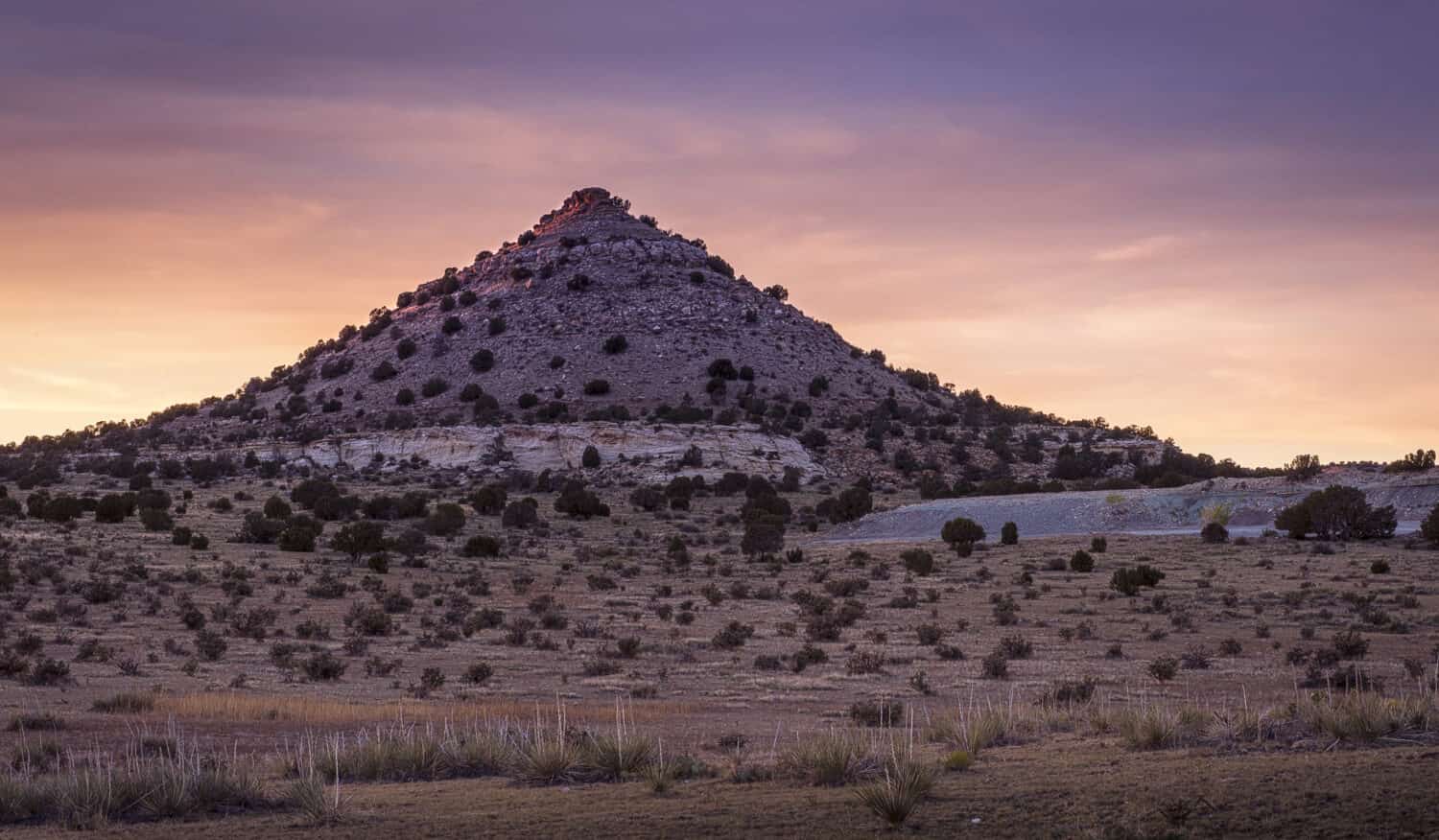
Flat, arid plains and rugged hills characterize the Pandhandle’s landscapes.
©John A Davis/Shutterstock.com
This land, disputed for decades, is characterized by arid and flat plains, earning its nickname of “No Man’s Land.” It’s also the site of Black Mesa, the state’s highest point, an area full of surprises and worth visiting. You will find ghost towns, dinosaur bones, and wagon tracks from the Santa Fe Trail. Today, the land attracts dozens of visitors as a great road-trip destination.
Home to many Native American Tribes, the area remains rural, with agriculture and cattle ranching bringing the most significant economic activities. Cimarron County, which kept its name from the illegal settlers, is the least populated in the state. Only 1% of all Oklahomans live in the panhandle.
Discover Oklahoma’s Distinct Regions
Oklahoma is broadly divided into four distinct geographic regions. Unique landscapes, natural features, and cultural significance characterized each of them.
Great Plains Region
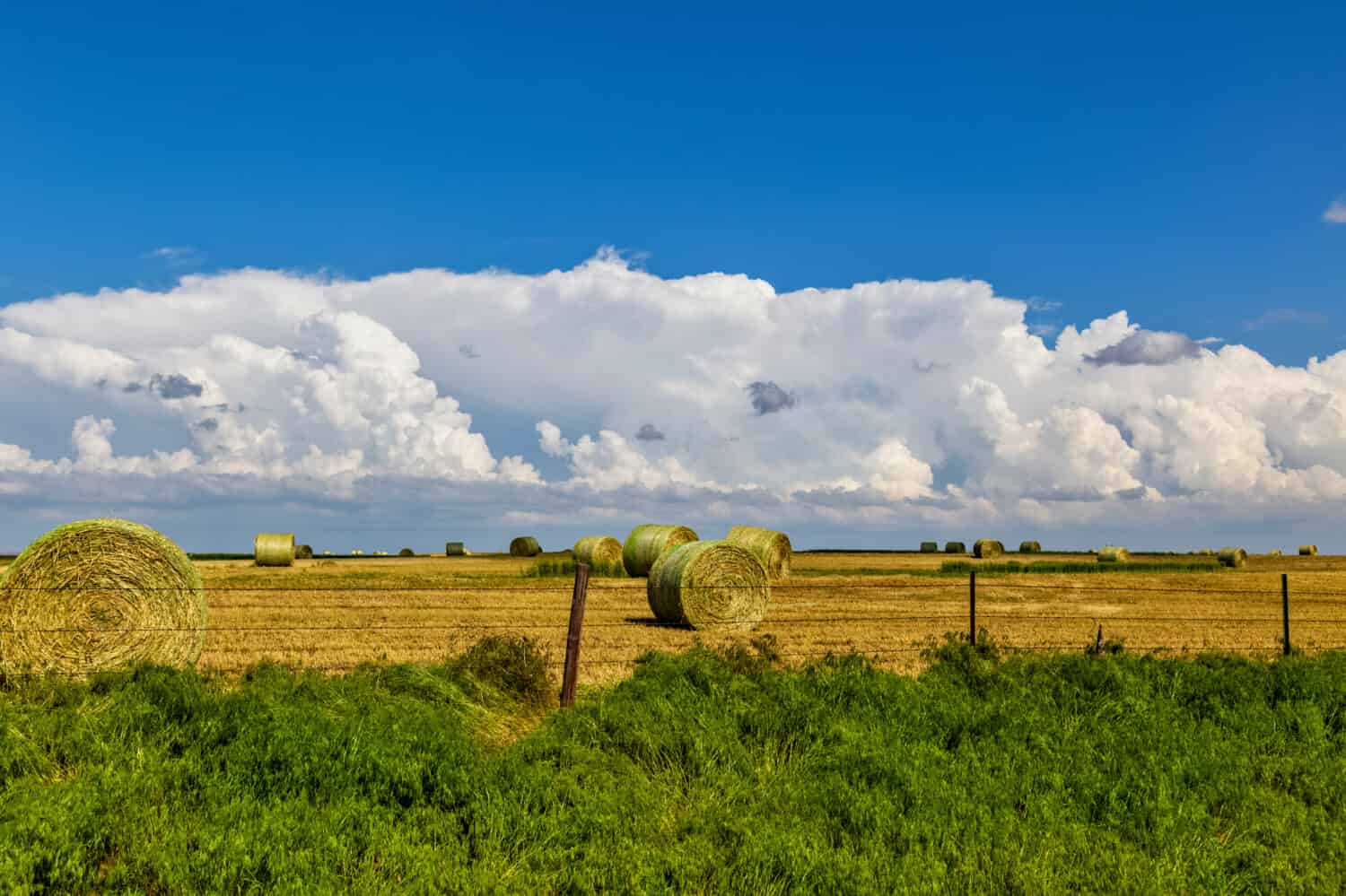
The Great Plains constitute a significant part of the state’s agriculture.
©Cary Meltzer/Shutterstock.com
Located in the western part of Oklahoma and in the panhandle, the Great Plains region dominates a significant portion of the state. Rolling prairies, grasslands, and occasional mesas compose most of the Great Plains.
The Great Plains is an essential agricultural region, with hot summers, cold winters, and relatively low precipitation. Corn, wheat, and sorghum thrive in the fertile soils. The area is also well-known and significant for cattle farming and ranching.
Here are spots worth a visit in the Great Plains:
- Black Mesa, the highest point in the state, rises to 4,973 feet above sea level.
- Wichita Mountains Wildlife Refuge, with stunning landscapes and wildlife
- Santa Fe Trail
- Twister The Movie Museum
Ozark Plateau Region
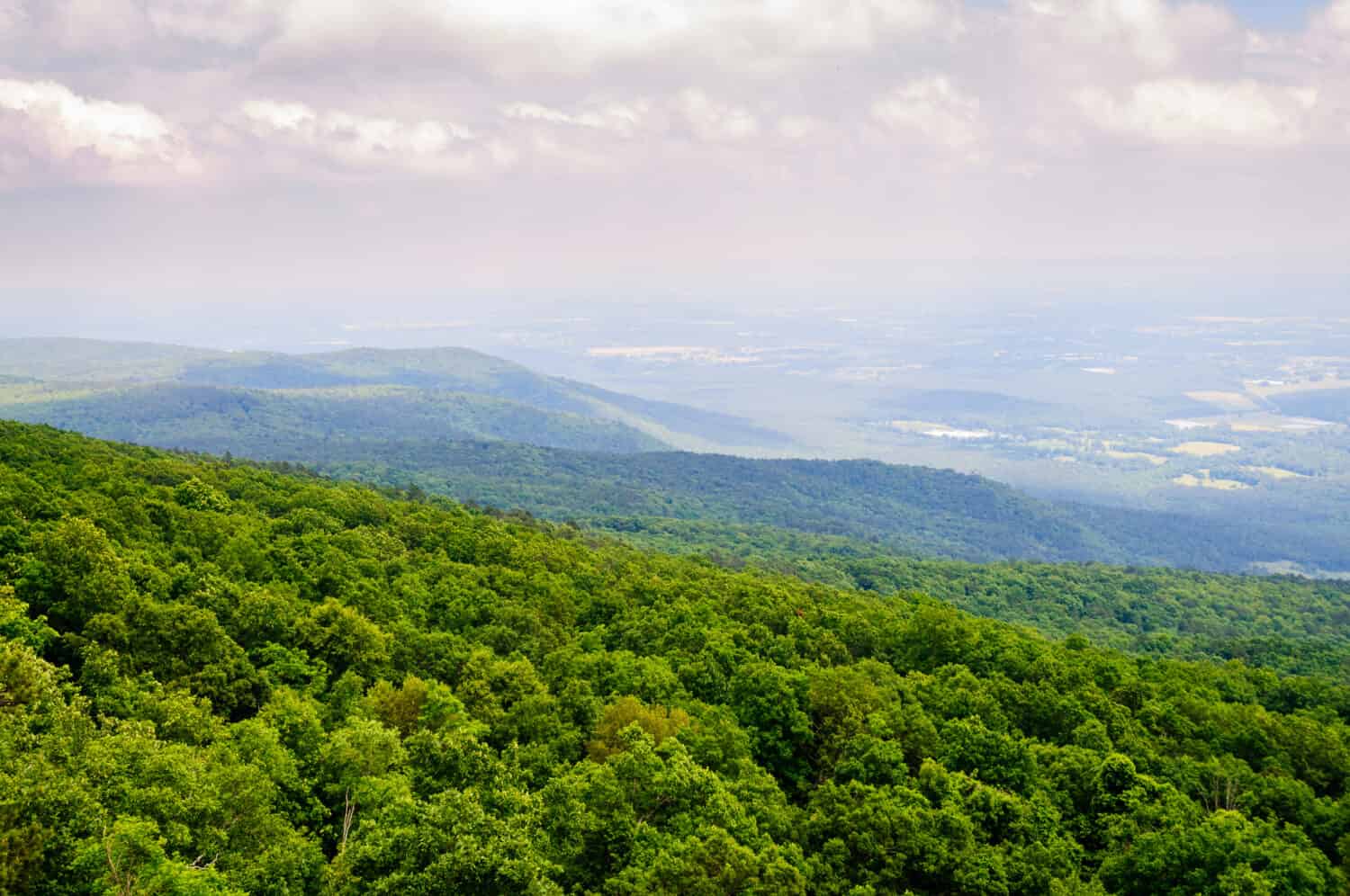
The Ozark Plateau is home to lush forests and vibrant biodiversity.
©Zack Frank/Shutterstock.com
The northeastern corner of Oklahoma is home to the Ozark Plateau that extends into Arkansas and Missouri. Lush forests, rugged hills, and scenic landscapes characterize the area. Geologically distinct from the rest of Oklahoma, it provides a thriving habitat for various plants and animal species.
Haven for outdoor enthusiasts, it offers camping, hiking, and fishing opportunities. With numerous lakes, rivers, and streams, it is a popular destination for water-based activities.
Cross Timbers Region

Prairies and woodlands can both be found in the Cross Prairies.
©The Bohemian Lens/Shutterstock.com
Running diagonally from the northeast to the southwest, the Cross Timbers is a unique zone between the Great Plains and the Ozark Plateau. This transitional area consists of dense woodlands interspersed with rolling prairies. Post oak and blackjack oat trees thrive in the Cross Timbers.
Historically, early settlers struggled to cross the Cross Timbers due to many obstacles when making their way westward, the region then earning the name “timbered crossing.”
Nowadays, the Cross Timbers also offer hiking trails and wildlife observation. As the Ozark Plateau, it provides habitats for multiple wildlife species contributing to biodiversity in Oklahoma.
Arbuckle Mountains Region
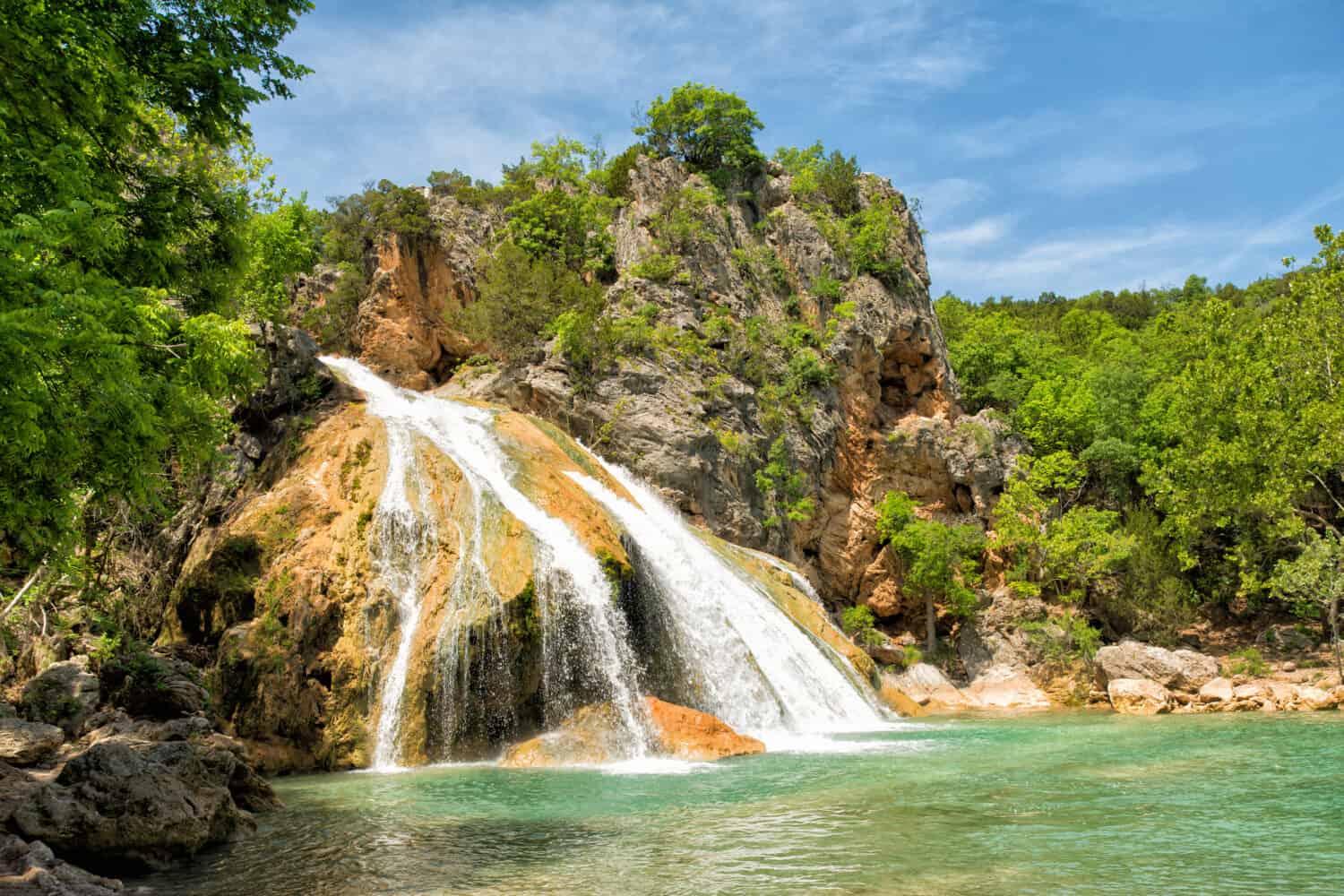
Oklahoma has some hidden treasures, like Turner Falls.
©Sari ONeal/Shutterstock.com
Last but not least, the Arbuckle Mountains, in the southern part of the state, are ancient mountain ranges. They offer a sharp contrast to the surrounding plains and plateaus. Classified as mountains, they are weathered by time and look more like rugged hills nowadays.
These mountains boast unique geological formations, such as limestone caves, sinkholes, and stunning waterfalls. Turner Falls is one of Oklahoma’s most famous natural jewels, drawing visitors to its picturesque cascades and swimming areas.
Arbuckle Mountains are a sought-after destination for nature enthusiasts and adventure seekers, thanks to its diverse landscapes.
From the vast open prairies of the Great Plains to the rugged hills of the Ozark Plateau and the waterfalls in the Arbuckle Mountains, each region has its own story to tell, reflecting this dynamic state’s rich history and natural heritage.
Discover Oklahoma’s Biodiversity
Oklahoma’s diverse geography with the Great Plains, Ozark Plateau, Cross Timbers, and Arbuckle Mountains provides a rich habitat for various flora and fauna. From native grasslands to lush forests, the state is home to numerous plant and animal species.
Flora

Various species of trees thrive in the Ozark Plateau and the Arbuckle Mountains.
©Kit Leong/Shutterstock.com
In the Great Plains, native grasses play a crucial role in the ecosystem. Species like switchgrass, Indian grass, big bluestem, and little bluestem dominate the prairies and provide food and shelter for various wildlife. As the most arid region of the state, cacti, like the prickly pear cactus, are common in the Great Plains. Drought-resistant, these plants have well adapted to the living conditions.
In other regions, the ecosystem supports a diverse range of three species. The Arbuckle Mountains host deciduous and coniferous trees, including hardwood species and eastern red cedar. The Ozark Plateau is home to pine, oak, and hickory trees, while blackjack and post oak grow in the Cross Timbers.
Wildflowers add vibrant splashes of color to the landscape of Oklahoma throughout the year. The Indian blanket, purple coneflower, black-eyed Susan, and wild bergamot are popular in the state and attract butterflies and bees.
Fauna
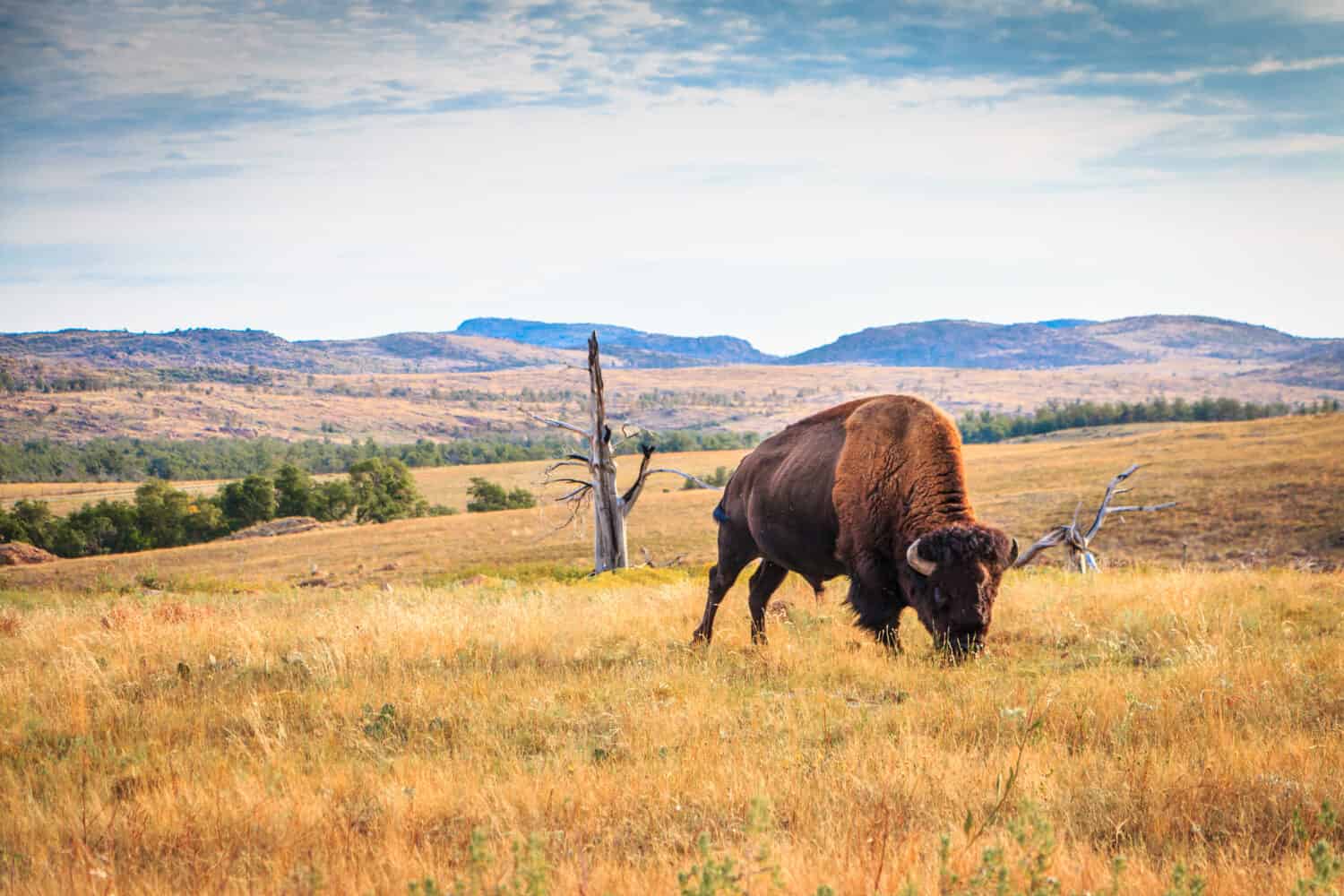
Many bison live in the Great Plains area.
©angie oxley/Shutterstock.com
With its stunning landscapes and large rural areas, Oklahoma is ideal for observing vibrant wildlife. One of the most iconic ones is the American bison, which was successfully reintroduced in Oklahoma. Visitors can see them peacefully in areas like the Tallgrass Prairie Reserve. Other large mammals like the white-tailed deer and bobcats thrive in the state’s diverse landscapes, from woodlands to grasslands.
Now on to smaller species, various raptors find their home in Oklahoma, from the bald eagle to the red-tailed hawk and great horned owl. Look closely, and you might see them soaring through the skies.
Back on the ground, numerous snake species thrive in the state in the various landscapes. Some include the bullsnake, the western diamondback rattlesnake, and the copperhead.
Oklahoma’s ecosystem thrives on its water bodies. Those are also teeming with various fish species such as catfish, crappie, bluegill, or largemouth bass.
The state created various wildlife refuges and protected areas to protect Oklahoma’s thriving flora, fauna, and habitats. The Oklahoma Department of Wildlife Conservation and multiple other organizations work hard to ensure the management of the state’s natural resources.
What to Do and What to Try in Oklahoma?
Visiting Oklahoma offers a rich blend of history, culture, and natural beauty. As an affordable destination with vibrant cities and stunning landscapes, it is definitely a trip to consider!
- Immerse in the rich Native American Heritage with museums, historical sites, and cultural centers.
- Visit the scenic and stunning landscapes within the four main regions: the Arbuckle Mountains, Cross Timbers, Great Plains, and the Ozark Plateau. Those will satisfy any adventure seekers!
- Explore the part of Route 66 that crosses through Oklahoma.
- Go and watch a rodeo! The Sooner State is home to a heavy cowboy heritage.
- A wide range of festivals and events celebrate music, food, and Native American heritage.
Food to Try in Oklahoma!

BBQ is a significant part of the Oklahoman culture.
©Peera_stockfoto/Shutterstock.com
The food scene in the state is diverse thanks to the various cultural influences. If you decide to take a trip down to Oklahoma, from BBQ joints, Native American fry bread, chicken fried steaks, and Tex-Mex cuisine, here are the top foods you can not miss.
- BBQ: As in other states, Oklahoma has a strong barbecue culture. You can taste BBQ joints and various smoked meats, including ribs, brisket, and pulled pork.
- Chicken Fried Steak: A favorite and beloved comfort food in Oklahoma, this specialty is a breaded and fried beef steak with creamy gravy. Often served with green beans and mashed potatoes.
- Indian Tacos: Discover a unique twist on tacos made with fry bread instead of tortillas.
- Sausage gravy over baked biscuits, which makes a great morning meal.
- Fried Okra: Okra is a popular vegetable in Oklahoma, often deep-fried and breaded to create a crispy and delicious side dish.
- The official state dessert is peach cobbler. Perfect during summer, it is usually served with vanilla ice cream. If you want to find the best cobbler in the state, head towards Tulsa to Cobbler Mom.
- If you’re off exploring Route 66, take a pit stop to drink a soda at Pops near Edmond. In this traditional American restaurant, also called “Pops 66 Soda Ranch”, you can try as many sodas as you want!
Oklahoma might not be the largest state or the most popular. But if you are willing to go for a visit, it offers an incredible array of activities, landscapes, culture, and food to offer. Plus, it’s one of the most wallet-friendly places to visit in the United States.
Where Does Its Flag Come From?
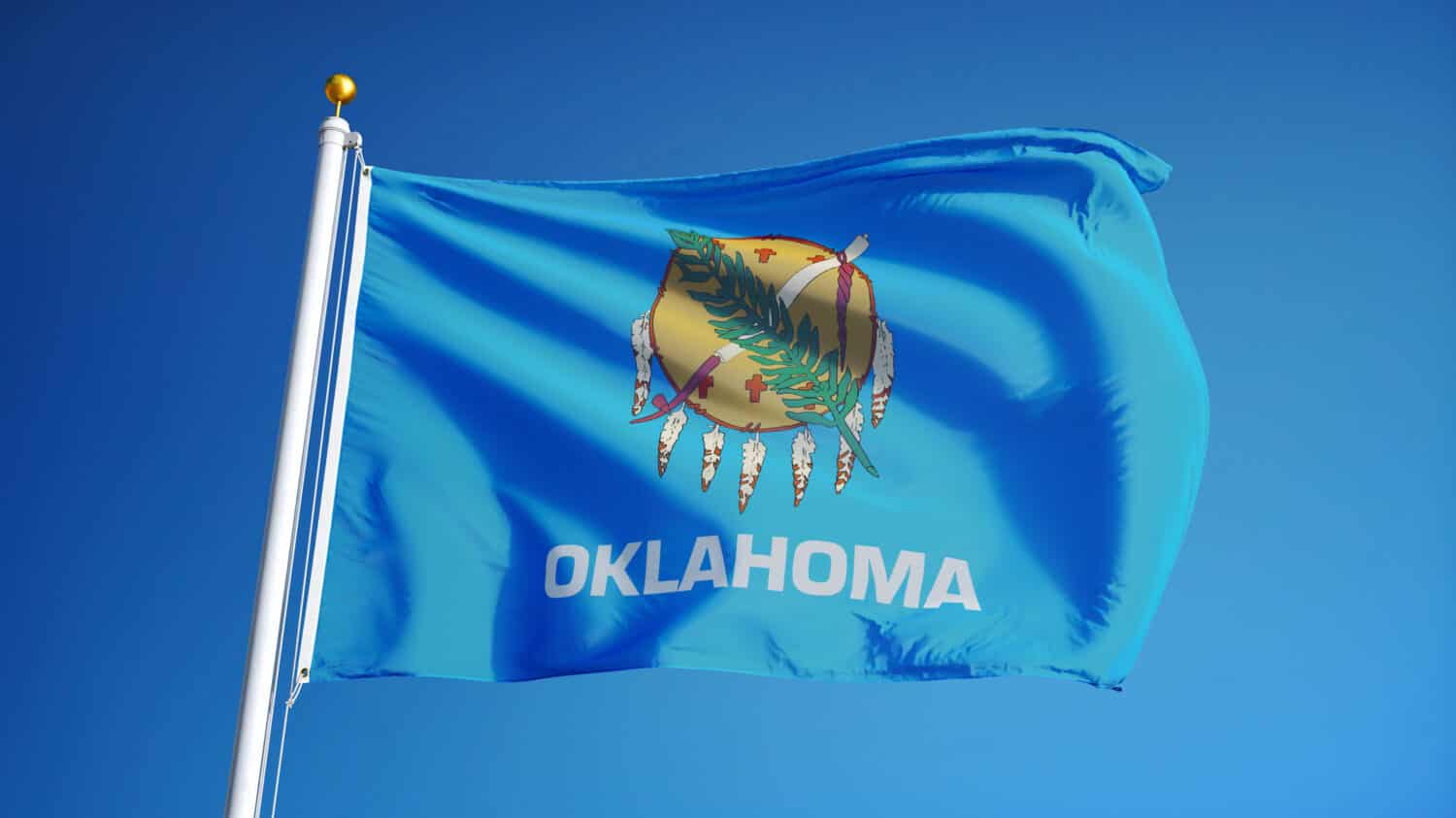
Oklahoma’s flag was last modified in 2006.
©railway fx/Shutterstock.com
The state of Oklahoma adopted its flag in 1925. It is composed of a traditional Osage buffalo-skin shield with seven eagle feathers above the word ‘Oklahoma’ in white on a Choctaw sky blue field. Two symbols of peace cover the shield: the Plains-style ceremonial pipe representing Native Americans and the olive branch for European Americans. Six golden brown crosses, Native American symbols for stars, are also on the shield.
The blue field represents devotion and loyalty, and the shield’s defensive and protective warfare symbolizes peace by a united group. Oklahoma is the only state besides New Mexico to include a distinct Native American iconography on its flag.
Thank you for reading! Have some feedback for us? Contact the AZ Animals editorial team.








